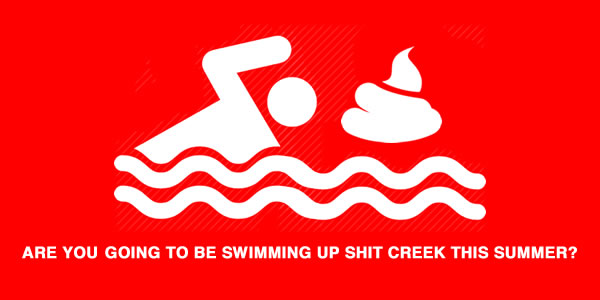Many of our waterways are full of excrement. As you’d expect, this stuff poses a massive health issue for people that want to swim in or drink the water from our streams, rivers, lakes and even aquifers. Between 18,000-34,000 Kiwis contract a waterborne disease every year; probably more if you include those that get a dose of the runs but keep it to themselves.
Drinking supplies – particularly in rural areas with low populations – can cause problems. One quarter of our measured waterways are either questionable (greater than 1% risk of infection) or downright unsafe for swimming (greater than 5% risk of infection) because they are full of crap. The problem is biggest in towns and cities (thanks to poor sewage treatment), and in pasture areas (thanks to farm animals, and occasionally wild birds).
This blog is about the scale of the problem. Our next blog on this topic will look more at the causes, and what we can do about them.
Bacteria 101
Poop, crap, turds, shit, bacteria, excrement, E coli – whatever you want to call it – traces are found in the vast majority of our waterways. E coli is just one of the many different bacteria that are found in poo, and end up in our waterways. It gets used as an indicator because it is the easiest to measure, not because it is necessarily the worst bacteria around.
There is not really any level of E coli where the water is definitely unsafe – it is a matter of risk. The more E coli there is the water, the bigger the chance of other nasty bugs being in there too. If you drink that water, either on purpose or by accident (during a swim), then high levels of E coli mean you have a bigger chance of ending up with diarrhoea (or worse).
How bad is the problem?
The short answer is that we don’t really know. An estimated 18,000 – 34,000 people annually contract waterborne diseases. The true figure is likely to be much higher, particularly for minor tummy bugs where people don’t even go to the doctor. However, the cause of these diseases varies and just because they can be transferred by water doesn’t mean they are all caused by poor quality water. For example, poor hygiene around food preparation can also be a cause.
Where the fresh water supply is a cause, the risk is highest in small rural communities, where the drinking water often isn’t up to the national standard of less than 1 E coli per 100ml of water. The standards are a bit looser when it comes to the Government’s standards for our freshwater, which govern suitability for swimming and other recreation activities:
| Standard |
|
What it means in practice |
| Drinking Water | Less than 1 | You can drink it safely |
| NOF Band A | Less than 260 | You can swim in it with less than a 1% chance of infection |
| NOF Band B | 260 – 540 | You could swim in it but be careful – there is a 1-5% chance of infection |
| NOF Band C | 540 – 1,000 | You shouldn’t swim in it, but you can wade in it with less than a 5% chance of infection |
| NOF National Bottom Line | 1,000 | Any more than this and you have a greater than 5% chance of infection even when wading |
According to data from the Ministry for the Environment, of the 700+ rivers measured for E. coli, around 74% were in band A, 18% were in Band B, 6% were in Band C and 2% were below the national bottom line. This may not sound too bad, but in our view there has to be a pretty good reason for a natural waterway to not be fit to swim in – so we have to look closely at the quarter of our measured rivers that are not in Band A. The only waterways where the water is safe enough to drink are in completely natural landscape – mountains or native forest.
Holy crap! Where is bacteria a problem?
As you can tell by the map below, this problem is worst in populated and intensively farmed areas. Basically, the more people or animals there are in an area, the more poo they make, and the more ends up in our waterways. The animals in question are usually farmed, but on occasion include wild bird populations.

New Zealand e coli levels heat map
Source: http://www.mfe.govt.nz/environmental-reporting/fresh-water/river-condition-indicator/bacteria.html
On average, waterways near our towns and cities are the worst. E coli levels in our urban waterways are (on average) 100 times natural levels. This is due to inadequate sewage treatment. However, these only make up a tiny fraction – some 1% – of our waterways. Waterways flowing through pasture areas make up bigger chunk of the country – 46% – and E coli levels in these are 40 times the natural level. This is due to animals – mostly the farmed ones – though occasionally flocks of birds can also cause a problem with E coli.
The risk of inadvertently swallowing some poo is highest after a big rainfall, when animal poo can get caught in the flood and washed into waterways. Rainfall can also overwhelm sewage treatment plants in towns and cities, with untreated sewage ending up in waterways.
In short, the Government’s bottom lines say that only 2% of rivers have a poo problem. However we disagree. If we want swimmable rivers, then up to a quarter of our measured rivers need a closer look. Safe drinking supplies in rural areas is another important reason.

